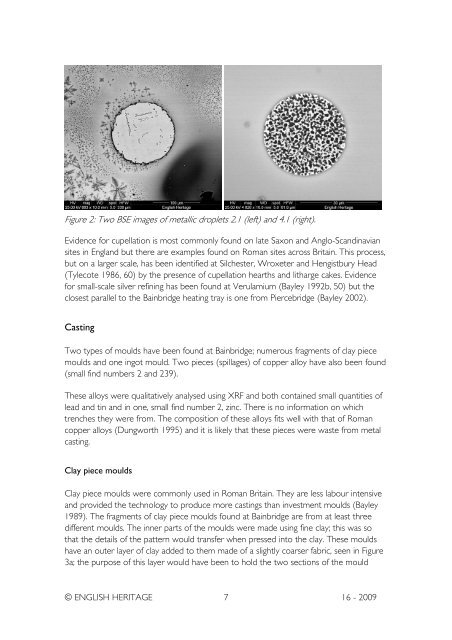THE ROMAN FORT AT BROUGH, BAINBRIDGE ... - English Heritage
THE ROMAN FORT AT BROUGH, BAINBRIDGE ... - English Heritage
THE ROMAN FORT AT BROUGH, BAINBRIDGE ... - English Heritage
You also want an ePaper? Increase the reach of your titles
YUMPU automatically turns print PDFs into web optimized ePapers that Google loves.
Figure 2: Two BSE images of metallic droplets 2.1 (left) and 4.1 (right).<br />
Evidence for cupellation is most commonly found on late Saxon and Anglo-Scandinavian<br />
sites in England but there are examples found on Roman sites across Britain. This process,<br />
but on a larger scale, has been identified at Silchester, Wroxeter and Hengistbury Head<br />
(Tylecote 1986, 60) by the presence of cupellation hearths and litharge cakes. Evidence<br />
for small-scale silver refining has been found at Verulamium (Bayley 1992b, 50) but the<br />
closest parallel to the Bainbridge heating tray is one from Piercebridge (Bayley 2002).<br />
Casting<br />
Two types of moulds have been found at Bainbridge; numerous fragments of clay piece<br />
moulds and one ingot mould. Two pieces (spillages) of copper alloy have also been found<br />
(small find numbers 2 and 239).<br />
These alloys were qualitatively analysed using XRF and both contained small quantities of<br />
lead and tin and in one, small find number 2, zinc. There is no information on which<br />
trenches they were from. The composition of these alloys fits well with that of Roman<br />
copper alloys (Dungworth 1995) and it is likely that these pieces were waste from metal<br />
casting.<br />
Clay piece moulds<br />
Clay piece moulds were commonly used in Roman Britain. They are less labour intensive<br />
and provided the technology to produce more castings than investment moulds (Bayley<br />
1989). The fragments of clay piece moulds found at Bainbridge are from at least three<br />
different moulds. The inner parts of the moulds were made using fine clay; this was so<br />
that the details of the pattern would transfer when pressed into the clay. These moulds<br />
have an outer layer of clay added to them made of a slightly coarser fabric, seen in Figure<br />
3a; the purpose of this layer would have been to hold the two sections of the mould<br />
© ENGLISH HERITAGE 7<br />
16 - 2009

















